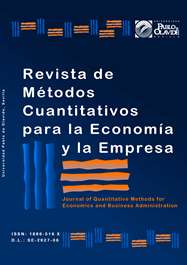Analysis of productivity in the Health Care Centers of the Community of Madrid (Spain) 2015-2017
DOI:
https://doi.org/10.46661/revmetodoscuanteconempresa.4271Keywords:
productivity, Hicks-Moorsteen Index, Färe-Primont Index, Health CentersAbstract
The main objective of this work has focused on extending the existing literature on the analysis of total factor productivity of the Health Care Centers (HCC) of the Community of Madrid (Spain) in the period 2015-2017, with two important contributions; the application and comparison of the Malmquist indices with two robust methodologies such as the Hicks-Moorsteen and Färe Primont indices which, except for error, have not been previously used in this sector and the regional scope, which has been scarcely analyzed. The main results reveal decreases in HC productivity due to the three proposed methodologies. These decreases range between 4.90% and 0.25% for the Färe-Primont and Hicks-Moorsteen indices respectively between 2015/17 in average terms. Convergence analyses confirm that this takes place in the case of the Malmquist and Hicks-Moorsteen proposals.
Downloads
References
Balk, B.M. (2001). Scale Efficiency and Productivity Change. Journal of Productivity Analysis, 15(3), 159-183.
Barnum, D., Johnson, M., & Gleason, J.M. (2016). Importance of Statistical Evidence in Estimating Valid DEA Scores. Journal of Medical System, 40, 47-59.
Barro, R.J., & Sala-i-Martin, X. (1992). Convergence. Journal of Political Economics, 100(2), 223-251.
Caves, D. W., Christensen, L. R., & Diewert. W. E. (1982). The Economic Theory of Index Numbers and the Measurement of Input, Output, and Productivity. Econometrica, 50 (9), 1393–1414.
Cordero-Ferrera, J.M., Nuño-Solinis, R., Orueta, J.F., Polo, C., Del Rio-Cámara, M., & Alonso-Morán, E. (2016). Evaluación de la eficiencia técnica de la atención primaria pública en el País Vasco, 2010-2013. Gaceta Sanitaria, 30(2), 104-109.
Cordero-Ferrera, J.M., Crespo-Cebada, E., & Murillo-Zamorano, L.R. (2011). Measuring technical efficiency in primary health care, The Effect of exogenous variables on results. Journal of Medical System, 35, 545-554.
Delgado, M., & Fariñas, J.C. (2002). Firm productivity and export markets, a non-parametric approach. Journal of International Economics, 57(2) 397-422.
Färe, R., Grosskopf, S., Norris, M., & Zhang, Z. (1994). Productivity Growth, Technical Progress and Efficiency Change in Industrialized Countries. American Economic Review, 84(1), 66–83.
Flores, I. (2019, 24 April). Bajo mínimos. Retrieved from https,//elpais.com/elpais/2019/04/23/opinion/1556042649_143602.html
García-Latorre, F., Marcuello, C., Serrano, G.D., & Urbina, O. (1996) Evaluación de la eficiencia en centros de atención primaria. Una aplicación del análisis envolvente de datos. Revista Eso Salud Publica, 70, 211-220.
Grifell-Tatjé, E., & C.A. Lovell, K. (1995). A note on the Malmquist index. Economics Letters, 47(2) 169-175.
Lovell, C.K. (2003). The Decomposition of Malmquist Productivity Index. Journal of Productivity Analysis, 20(3), 437-458.
Martínez-Cillero, M., & Thorne, F. (2019). Sources of productivity growth using the Färe-Primont decomposition. An empirical application to the Irish beef sector. Applied Economics, 51(36), 3982-3994.
Mateos, A., & Penedés, A. (2013). España, Crisis y recortes. Revista de ciencia política, 33(1), 161-183.
O’Donnell, C.J. (2008). An Aggregate Quantity-Price Framework for Measuring and Decomposing Productivity and Profitability Change. Working paper series, No. WP07/2008, University of Queensland.
O'Donnell, C.J. (2011). Econometric Estimation of Distance Functions and Associated Measures of Productivity and Efficiency Change. Centre for Efficiency and Productivity Analysis Working Papers WP01/2011. University of Queensland.
Pelone, F., Kringos, D.S., Romaniello, A., Archibugu, M., Salsiri, C., & Ricciardi, W. (2015). Primary Care Efficiency Measurement Using Data Envelopment Analysis. A Systematic Review Journal of Medical System, 39(1), 156-177.
Puig-Junoy, J. (2000). Eficiencia en la atención primaria de salud, Una revisión crítica de las medidas frontera. Revista Española de Salud Pública, 74, 483-495.
Quah, D.T. (1997). Empirics for Growth and Distribution, Stratification, Polarization and Convergence Clubs. Journal of Economic Growth, 2, 27-59.
Romano, J., & Choi, Á. (2016). Medida de la eficiencia de la atención primaria en Barcelona incorporando indicadores de calidad. Gaceta Sanitaria, 30(5), 359-365.
Russell, R. (2018). Theoretical productivity index. The Oxford handbook of productivity analysis. Oxford: Emili Grifell-Tatjé, C. A. Knox Lovell, & Robin C. Sickles. DOI: 10.1093/oxfordhb/9780190226718.013.4.
Scott, D.W. (1992). Multivariate density estimation; Theory, practice, and visualization. New York: Wiley.
Segura, A. (2014). Recortes, austeridad y salud. Gaceta Sanitaria, 28(S1), 7-11.
Stokey, N.L., & Lucas, R.E. (1989). Recursive methods in Economics Dynamics. Massachussets: Harvard University Press.
Vafaee, A., Pooya, A., Alizadeh, A., & Emrouznejad, A. (2018). Assessing the Relative Performance of Nurses Using Data Envelopment Analysis Matrix (DEAM). Journal of Medial System, 42, 125-134.
Vieira, M., (2018, 24 September). España tiene el sistema sanitario más eficiente de Europa y el tercero del mundo, según el informe Bloomberg, Diario Enfermero. Retrieved from http,//diarioenfermero.es/espana-tiene-el-sistema-sanitario-mas-eficiente-de-europa-y-el-tercero-del-mundo-segun-el-informe-bloomberg/
Downloads
Published
How to Cite
Issue
Section
License

This work is licensed under a Creative Commons Attribution-ShareAlike 4.0 International License.
Submission of manuscripts implies that the work described has not been published before (except in the form of an abstract or as part of thesis), that it is not under consideration for publication elsewhere and that, in case of acceptance, the authors agree to automatic transfer of the copyright to the Journal for its publication and dissemination. Authors retain the authors' right to use and share the article according to a personal or instutional use or scholarly sharing purposes; in addition, they retain patent, trademark and other intellectual property rights (including research data).
All the articles are published in the Journal under the Creative Commons license CC-BY-SA (Attribution-ShareAlike). It is allowed a commercial use of the work (always including the author attribution) and other derivative works, which must be released under the same license as the original work.
Up to Volume 21, this Journal has been licensing the articles under the Creative Commons license CC-BY-SA 3.0 ES. Starting from Volume 22, the Creative Commons license CC-BY-SA 4.0 is used.










